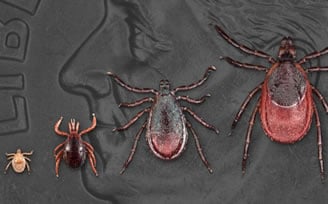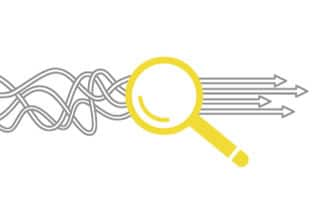New Findings Inform Modernization of Lyme Disease NNDSS Data

To improve accuracy and address gaps in data completeness and quality of Lyme disease data sent to CDC using the National Notifiable Diseases Surveillance System (NNDSS), the Lyme disease surveillance team in CDC’s Division of Vector-borne Diseases analyzed NNDSS Lyme disease data submitted to CDC between 2008 and 2018.
The review identified the following data gaps:
- Formatting of the data was modified over time, which contributed to mapping and transmission errors.
- Free-text elements increase the likelihood of inconsistencies and unusable data.
- Surveillance epidemiologists are likely collecting most of the Lyme disease data elements, but a large amount of the data is not reaching CDC.
CDC used the analysis to inform implementation of a new message mapping guide that can facilitate transmission of the same Lyme disease information as older case notifications, but with clearer guidance on what to send and fewer free-text data elements to reduce the potential for errors and incomplete data. This will provide decision-makers with more meaningful data to guide public health action.
The analysis also reinforces familiarity with data transmission methods among the nation’s public health workforce as increasingly important to modernization of the nation’s public health data systems in support of the CDC Data Modernization Initiative. Collaboration between epidemiologists and informaticians in jurisdictions and at CDC is key. This helps informaticians understand the epidemiological context during the data element mapping process and ensures that epidemiologists know which data elements are mapped for transmission to CDC.
Full Story
Public health problem
Lyme disease data sent by public health jurisdictions to CDC through the National Notifiable Diseases Surveillance System (NNDSS), managed by CDC’s Division of Health Informatics and Surveillance, have played a critical role in understanding geographic patterns in the spread of Lyme disease and identifying people who are most at risk of exposure and illness.

In addition to core NNDSS data, such as demographic information about people who get Lyme disease, CDC also received additional Lyme disease-specific clinical and laboratory data in the case notification.
However, the data elements requested had not been updated since 1991, despite Lyme disease consistently being the most common vector-borne disease and one of the most common notifiable diseases nationwide.
In addition, there have been many changes in public health technologies, surveillance systems and databases used to send and store Lyme disease data, and mechanisms for sending disease data such as electronic laboratory reporting. As a result, the system CDC was using to collect Lyme disease data was too outdated for today’s public health surveillance landscape.
Furthermore, turnover in personnel working on Lyme disease surveillance left a knowledge gap about the original intent and format of many data elements.
As a result, Lyme disease data sent to CDC were often incomplete or the case notification had transmission errors, making the data less useful for informing public health action.
Actions Taken
To improve the completeness and quality of data about cases of Lyme disease, CDC developed a new message mapping guide (MMG) for Lyme disease and tick-borne rickettsial diseases (TBRD). As CDC worked to develop the new MMG, the Lyme disease surveillance team in CDC’s Division of Vector-borne Diseases wanted to identify and avoid challenges with the older set of data elements. The team analyzed Lyme disease data submitted to CDC between 2008 and 2018. These data included:
- coded data elements, which use standardized codes to capture information such as clinical signs, laboratory test results, hospitalization, and pregnancy status;
- date and numeric data elements, which capture information such as diagnosis and report dates and treatment duration; and
- “free-text” variables, which allow a user to freely input written information such as types of treatment, exposure, and other clinical signs.
The team’s analysis found that completeness was less than 50% for most coded and date/numeric elements, meaning that a large portion of the data was either not available or not in a useable format.
When analyzing free-text data, the team found that information provided for these data elements often exceeded character limits and did not always include useful information. Often free-text information referenced other data elements that had not been shared with CDC.
Finally, the team found that free-text information often conflicted with other information in the case notification message and data that were in the correct format but in the incorrect position within the message.
These findings suggest the following:
- Surveillance epidemiologists are likely collecting most of the Lyme disease data elements, but a large amount of the data is not reaching CDC.
- As public health technology, systems, and personnel have changed since 1991, the intended format of data was often lost, resulting in mapping and transmission errors.
- Free-text elements increase the likelihood of inconsistencies and unusable data.
Outcome
Guided by the team’s findings, implementation of the new Lyme disease and TBRD MMG facilitates transmission of the same Lyme disease information as older case notifications, but with clearer guidance on what to send and fewer free-text elements to reduce the potential for errors and incomplete data.
This provides decision-makers with more meaningful data to guide public health action. The team’s analytic methods can continue to inform better strategies to improve case surveillance not only for Lyme disease, but for a variety of notifiable diseases and conditions.
The analysis also reinforces familiarity with data transmission methods among the nation’s public health workforce as increasingly critical to effective modernization of the nation’s public health data systems. Collaboration between epidemiologists and informaticians in jurisdictions and at CDC is key. This helps informaticians understand the epidemiological context during the data mapping process and ensures that epidemiologists know which data elements are mapped for transmission to CDC.
Jurisdiction adoption of the new MMG will be critical for modernization of Lyme disease and TBRD surveillance in support of the CDC Data Modernization Initiative.
Learn about how the new MMG is also modernizing surveillance for tickborne rickettsial diseases.